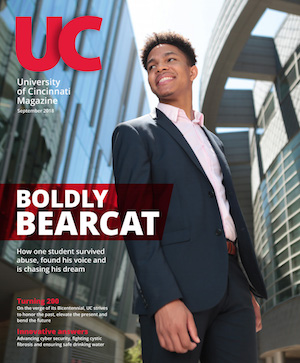December 15, 2010
Just in time for the holidays, a few University of Cincinnati graduates and entrepreneurial designers share some of the stories behind their favorite creations.
By Jayna Barker
Drawing inspiration from childhood
Most creative types have that ‘Eureka!’ moment -- a flash of genius preceded by a mental impasse. For toy designer Mike Hoeting, DAAP ’89, that pristine moment of clarity is much more than just ‘Aha.’ It starts with excitement, and then extreme paranoia immediately sets in. Fear morphs into panic as he dives into hours of research to make sure someone else didn’t come up with the design first and so no one does.
Perhaps Hoeting’s love for design came from his desire to develop radio-controlled airplanes during high school. He was always very interested in art, design and building. During his junior year in high school, he was having difficulty deciding on a possible college degree between architecture, mechanical engineering, commercial art and graphic design. It wasn’t until his father picked up a flyer from the University of Cincinnati College of Design, Architecture, Art and Planning that Hoeting realized what he wanted to do: industrial design.
“I didn’t know about industrial design,” he says. “It’s not marketed and understood as well as architecture and graphic design. But I read the program description, and I knew it was exactly what I wanted to do. It was the perfect blend of art and engineering.”
Shortly after graduation, Hoeting moved to Chicago and began working on the toy inventing side of design. After two years of hard work and a mental battle between staying in Chicago or moving back to Cincinnati to start his own toy-design company, he chose the Queen City. He co-founded a company with fellow UC alumnus Sean Mullaney, DAAP ’89, in 1991-- Bang Zoom Design -- and he’s been in the toy designing business ever since.
Currently the president of Bang Zoom Design, Hoeting has been designing toys for more than 20 years. Although he keeps his home and work lives separate, he plays a two-headed mastermind at the studio. When he’s not handling administrative and business issues, managing his eight designers, meeting deadlines or taking care of anything that requires management, he focuses on what he does best: design.
“Instinctually, I am 80 percent a designer,” he says. “I’m afraid if I don’t do enough (designing), my job wouldn’t be that interesting or fun.” And Hoeting has done plenty of designing -- he has more than a dozen toy patents attached to his name.
Which toy is his favorite? The RC Xtreme Cycle made by Tyco, owned by Mattel and designed by Hoeting. “When I was a child, the Evil Kenevil motorcycle was my favorite toy, but I had always wished it was remote controlled,” he says. “I always wanted to take it off ramps, make it jump and drive it around. It was a dream of mine to (design) a toy that did that.”
Luckily for Hoeting, his dream was patentable after he spent close to a year nurturing and exploring the idea and then prototyping it.
Often times it’s hard to develop a toy that creates a TV moment – something so different and unique that it communicates a “Wow” factor in a matter of seconds. Hoeting has to be creative not only in the design itself, but marketing the design as well. Engineering is considered in the development process -- not just how the toy is styled, but how it’s actually made.
Hoeting follows trends and is involved in a lot of back and forth with manufacturers and retailers to see if designs are appropriate for the market. Retailers are asking for toys that are trend related, like Harry Potter and Justin Beiber.
As far as inspiration goes, Hoeting doesn’t have any children to give him ideas. Much of his ideas he creates himself -- a way to please his inner child.
“I am a kid,” he says. “I guess I just haven’t grown up.”

 Past Issues
Past Issues
